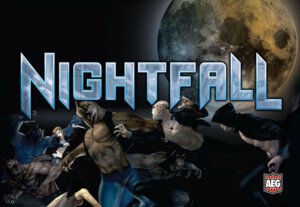Publisher: Alderac Entertainment Group
Designer: David Gregg
Artists: Conceptopolis, Thomas Deeny, Andrew Hepworth, Daniel Vendrell Oduber, and Florian Stitz
Year: 2011
Players: Two to five players
Ages: 12+
Genre: Vampire/Werewolf/Ghouls/Humans battle deckbuilding game
There are, as expected, a bevy of deckbuilding games appearing on the market nowadays. It’s getting harder for the newer games to add uniqueness to their game, so that it is not just another re-themed version of Dominion. Nightfall is not Dominion, nor is it Thunderstone, or Heroes of Graxia or anything else. There are features that help Nightfall stand on its own in an ever flooding market.
The theme, if you have been under that rock with the guy and the Geico sign, is horror. Ghouls, Vampires, Werewolves, and even some humans all make their appearance in the game. Like all of the deckbuilding games, there are multiple copies of the various cards that each of the players has an opportunity to acquire to put together a winning strategy. There are 24 different cards (not including the cards everyone starts the game with) and you only use 8 of these common cards in each game.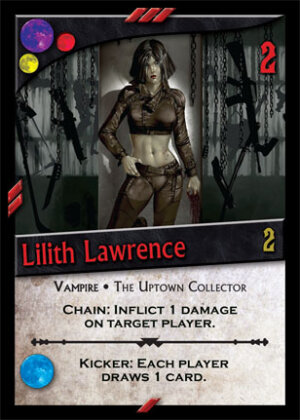
However, that’s where the first and second twist comes into play. At the beginning of the game, each player receives 4 random cards from the stack of “Draft Cards” (a single copy of all of the possible cards). Everyone gets a time to look at and select one card from the four dealt to them, and that card becomes their First Private Archive. In essence, they will be the only player who will be able to buy copies of that particular card throughout the game. Then the remaining 3 cards are passed to the left, and the players select a second card that is theirs and theirs alone to obtain as the game is played.
Cards are passed again and a third card is selected that is added to the common pool that all players will have access to, the fourth card is discarded by the players and will not be used in the game. The common pool is finished off by choosing cards randomly from the remaining draft cards until there are 8 common cards in the center of the table available to all players during the game.
So you get the fun of “Drafting” cards, and they become available to only you as your own personal stacks of cards to purchase from.
What about the cards themselves? The artwork is excellent. The minion cards have a health mechanic built into them which is interesting. There are marks on each edge of the card that represents that particular minions health. The strongest is health 4, as there are only 4 edges to a card. So the top of the card has 4 marks on it. If the minion takes 1 point of damage, rotate the card 90 degrees clockwise so that the edge showing 3 marks is now facing up. You continue to rotate the card as it takes damage until its health is depleted, at which point it is destroyed and removed. Each player starts the game with the same deck of 12 weak minion cards. You need to start getting better cards as soon as you can if you are going have any hope of winning.
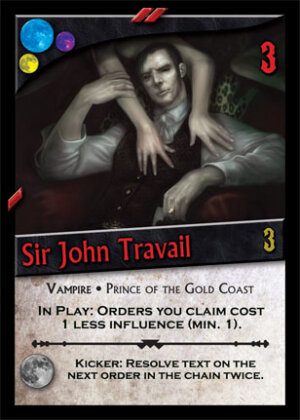
First is combat. All of your minions must attack someone(s) and after attacking are put in your discard pile (or removed entirely, in the case of your starting cards).
Second is the chain phase. This is the next interesting twist in the game. The player who’s turn it is can play one or several cards in a chain in front of them. The chain is formed by matching colored moon symbols in the top left corner of the card. There is one larger moon and two smaller moons beneath it. Each has a color. You play the first card in your chain, and if you have another card where the color of the large moon matches the color of one of the smaller moons on the card played, then you can chain that next card on to it. You can keep playing cards by chaining them together in this manner.
The catch? Each of the other players get to add cards to the chain if they have the matching colored symbol needed. In the end, you end up with a chain of cards that then take effect one by one in reverse order. So if it is your turn, your cards will actually take effect last. This has a lot of strategy built into it. You can get your minions out on the table now, so that you have something to attack and defend with, but you might run out of cards and have nothing to play on your own turn. There is a delicate balance and definite combos you can attempt. Additionally, many cards have a special ability called a “Kicker”, which activates if the card it is chained to matches the kicker color. This triggers the special ability which is always nice. You have to keep track of what is going on though, and there is no goofing around when it isn’t your turn or opportunity could pass you by.
The Problem? Colored symbols. No help for you if you are color blind. Plus they don’t seem to correspond to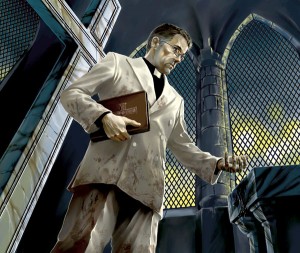
The mechanic is still cool and adds a new dimension to deckbuilding games.
Third is the claim phase where you can use your influence to purchase cards from the common pool or your own private archive stacks.
Finally is clean up, where you draw new cards. One note, if you take any damage from being attacked, you have to draw wound cards for each point of damage which go into your deck along with your other cards. There is a set number of wound cards based upon the number of players, and when the cards run out, the game is over. The person with the least amount of wounds wins the game. During clean up, if you draw a wound cards you can discard them and replace with two new cards for each wound. If you draw any more though, you are stuck with them.
There is also a tie breaker based upon the types of wounds received, To me this doesn’t make much sense, as the types you receive are completely random based upon what you draw out of the wound deck. It would have made more sense if the wounds possibly were kept in 3 separate piles, as currently there are burn, bleed, and bite wound cards. If you take a point of damage, draw a burn card. If you take two, draw a burn and a bleed card. If you take three, draw a burn, bleed, and bite card (four or more, start over at the beginning wound pile again). Thus only those who suffer tougher attacks end up getting bite cards, so in the event of a tie, the player with the fewest bite cards would win. That makes more sense to me, although I’m not sure how you would figure out how many of each to start the game with.
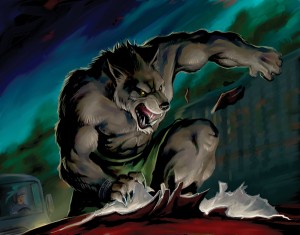
The cards each have their own special actions on them, as happens in most games of this type, which take some deciphering sometimes. Luckily they tried to head some of those questions off at the pass by including some FAQ in the rules. I loved the rules and found them entertaining as well as fairly nicely put together. There are some good examples included to get you over the stickier points of the rules. Also included in the rules are two theme appropriate stories for your enjoyment written by Kenneth Hite.
Overall, I had a great time playing once we figured out the rules and started to see the different strategic possibilities. No one was happy being forced to attack with everything and then discarding them all right at the start of your turn, but after a while it started to make sense and you realize how important timing is for playing your cards and the best time to slap a card onto a chain. I recommend Nightfall as a fun addition to your gaming collection.
- A Dungeon Delve for Kids?: A Review of Dungeon! - Oct 24, 2022
- Better, Stronger, Faster | Descent: Journeys in the Dark Second Edition Reviewed - Oct 23, 2022
- Your Planet is Doomed!: Invasion from Outer Space Reviewed - Oct 22, 2022



